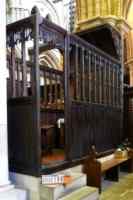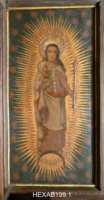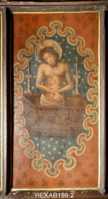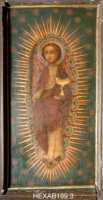 Click on
Click onThumbnail
for
18 photos
“Ancient painting discovered in the Abbey Pew or Ogle shrine on Oak frame and 3 Pannels meas 6F · 6 by 6F · 2 size of each picture within frame 3 · 8 by 1 · 10 half length of Saviour rising from the tomb centre surrounded by a clouded Oriel firmament studded with stars gilded. a sort of frame holds the half figure on each side of which stand two candles in candle sticks on each side the half figure rising from the tomb on the right, the Virgin and child, on the left, St John holding a chalice both surrounded by an Elaborite gilded glory whole length of pictures the background of picture of saviour diapered thus [IHS] with christian monogram. this painting in the possession of the Joiner (Herdman) contractor taking down Galleries & Pews. Mar 1859” [Joseph Fairless, Table-Book pt.1 p.19]
“The Ogle Shrine in Hexham Church stood on the south side of the choir in the third Arch or Bay from the East end. it was 7 Feet 8 In. high Breadth in front 10 Feet, from back to front 6 Ft 6 In Back of shrine 8 Feet and entrance door 2 Feet there was a carved canopy above meas. 2 Feet 9 in. by 3′ 0” [ibid. p.63]
“A curious triptych has been discovered at Hexham Abbey Church, which is now undergoing restoration. In taking down the Ogle shrine, which has been used as a pew probably ever since the Reformation, under the green baize with which it was lined appeared the altar-painting in question. It is set in a massive oak frame, 6 ft 6 in. by 4 ft 3 in. Each of the three panels is 3 ft 8 in. by 1 ft 10 in., and the subjects in each are confined within what is called a vesica. The centre painting represents the Saviour rising from the grave; that on the left is devoted to the Virgin and Child; the third compartment is filled with a representation of St John. These are all painted and adorned in the richest style of mediæval ornament.” [Illustrated London News, 6Sep1862 p.259]
“In the course of the removal of the Ogle shrine … a 15th-century altar painting was discovered in situ. The screen-work had been covered with green baize, and this work of early art was enshrouded within. This is a three-panelled altar picture, painted in the same style as the panels of the wonderful rood-screen. The subjects in each compartment are restricted to the vesica form, and have diapered backgrounds. … There are nails in parts of the picture by which the baize coverings have been fixed, and the base of the centre panel is not so perfect as the others; but it is in curious preservation considering the length of time it has been thus concealed. According to contract, it became the property of the joiner, of whom, after it bad remained two years in his attic, I purchased it.—F.R.W.” [F R Wilson, TAASDN, 1863 p.27]
“The Revd E J Taylor, drew the attention of the members to some notices which had appeared in the Newcastle Daily Journal respecting a triptych formerly in Hexham church. He said this interesting object had been removed during the restoration some years ago, and was in the possession of Mr Bond, of Newcastle. It had been suggested that it would be a graceful act on the part of Mr Bond to return it to the vicar and churchwardens, but Mr Bond being a dealer, had no doubt paid a good price for it, and would look at it from a business point of view. Could nothing be done by the society to secure it? A relic like this no doubt would soon be bought by some of our American cousins and transported to the other side of the Atlantic and lost to the neighbourhood. As a member who took a great interest in sacred archæology, he would suggest that a careful drawing or photograph be taken and reproduced in the Proceedings. Mr Hodges said that the triptych was removed during the ‘restoration’ of the church about 40 years ago when so much of the ancient woodwork was destroyed. It was taken possession of by the contractor as old material, and was purchased from him by the late Mr F R Wilson of Alnwick, whose representatives he supposed had disposed of it. It was stated that Mr Bond had since sold the object to Mr W D Cruddas, MP, who intended to fix it in his residence of Haughton castle, where doubtless every care would be taken of it.” [ProcSocAntNcle, 1896 Vol.VII No.21 p.175]
Triptych from Ogle Chantry to be restored [Hex.Par.Mag. Sep 1947 p3]
1960: Return of the Ogle Chantry panels via Miss Eleanor Cruddas's will.
Certain restoration work was carried out in the Abbey during the years 1838–1840 [sic]. A joiner doing part of this work then claimed that, according to his contract, the triptych could be regarded as part of the old material which he could remove. The then Rector [sic] and other custodians allowed him to do this. After it had lain in the joiner's attic for two years, the triptych was sold to a Mr F R Wilson, an Alnwick architect. Mr Wilson gave a description of it in an address he read before the Architectural and Archæological Society of Durham and Northumberland in July, 1862. He also exhibited the painting at a meeting of the Society of Antiquaries in Newcastle, on 4th March 1863. The fact of its removal from the Abbey was remarked upon and deplored in “The Builder” of October 27, 1860, and in “The Ecclesiologist” and “The Critic”. However, it remained in the possession of Mr Wilson's widow until 1895, though she offered it for sale in various quarters and could not find a buyer. Ultimately it was bought by a Mr Bond, of Northumberland Street, Newcastle. After he had had it for only a few days, it was sold by him to Mr W D Cruddas, in December 1895. [Abbey Chronicle, June 1960, p.1 – with photo]
1991: “New low voltage lighting installed in Ogle & Leschman Chantries” [Churchwardens Record HEXAB9535 p67, 10 Nov]
08Aug2022: “My 17-Times Great-Grandfather. | FRANK SIDNEY OGLES, b.3/2/1940” [Visitor recollection, no address]
EP 184/136 (1963) Correspondence re the Cruddas Triptych. Also copy of The Abbey Chronicle 1960, with article re return of triptych.
EP 184/154 (1969) Copies of printed note placed in Ogle Chantry.
EP 184/242 (n.d.) Two copies 1 typescript, 1 parchment of note re the Ogle Chantry.
1907. Faculty: 21 November. … 8. The restoration of Prior Leschman's and the Ogle Chantries and refixing thereof in their original positions in the ancient choir. NRO Faculty Book No.1, no.316; and NRO EP.184/80.
W Longstaffe, ‘The Ogle Shrine’, Archæologia Æliana, 1863 p.174
TAASDN = Transactions of the Architectural and Archæological Society of Durham and Northumberland vol.I 1862–1868.





